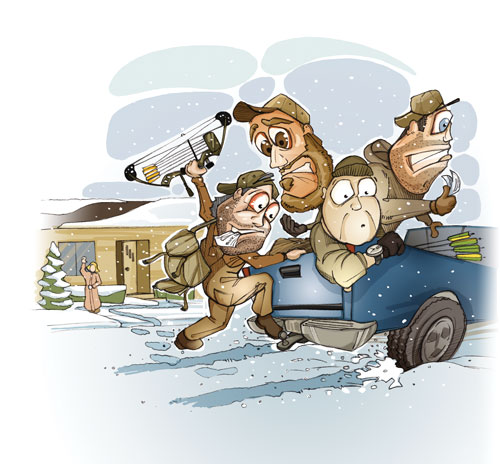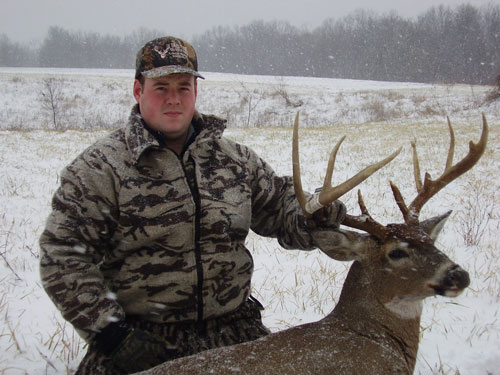Previously: Texas ranch hunting
 Another great whitetail hunting approach this time of year is hooking up with an outfitter in one of the big Midwestern whitetail trophy states. It’s ironic that these guys are overrun with more hunters than they can handle during the rut, then are abandoned come December. It’s ironic because almost to a man they tell me that the late season is the best time there is to kill a big buck — plus prices on hunts are typically deeply discounted. Ralph Cianciarulo from Archer’s Choice Media, a big late-season deer hunter himself, tells us why.
Another great whitetail hunting approach this time of year is hooking up with an outfitter in one of the big Midwestern whitetail trophy states. It’s ironic that these guys are overrun with more hunters than they can handle during the rut, then are abandoned come December. It’s ironic because almost to a man they tell me that the late season is the best time there is to kill a big buck — plus prices on hunts are typically deeply discounted. Ralph Cianciarulo from Archer’s Choice Media, a big late-season deer hunter himself, tells us why.
“We do a lot of food plots, and in the early season they can’t compete with agriculture, of course, but in the late season they turn on,” he says. “I’m talking winter peas, turnips, that kind of stuff.
“After the rut is over, bucks have one thing in mind, and that is food. Unlike the rut, you can pattern them,” Cianciarulo says. “Here, mid-December through early January can be the best time to kill a good buck.”
That “here” of course is Illinois, which for some reason seems to be a hotbed for this strategy. My first experience with it came when I was at a lodge in Calhoun County during a rut hunt. I was admiring all the buck mounts on the wall and asking about them. One of the guides pointed out that all were taken in late December and January.
An outstanding operation in west-central Illinois is Tall Tine Outfitters near Roodhouse. Here they harvest bucks all season long that average an amazing 142 inches, but main man Joe Gizdic says he likes the late season for a simple reason.
“You will see fewer big bucks in the late season than during the rut, but you’ll kill more of those that you see,” he says. “Success per sighting goes way up.”
That, of course, is because in the late season, deer are more concentrated and more patternable.
“We go out in the evenings and get in as close as we can between a bedding area and food source,” Gizdic says. “We’ll go out for a four- or five-hour sit — you need to get out early because while the deer move a lot around sunset, sometimes they’ll be out around 3 or 4 p.m., especially if a front is coming in. A lot of our stands are along ditch lines and grassy waterways, which the deer use for a little extra cover.”
 That was the classic setup used by Bob Rinderknecht to take a nice 146-inch buck in the prime time between Christmas and New Year’s.
That was the classic setup used by Bob Rinderknecht to take a nice 146-inch buck in the prime time between Christmas and New Year’s.
“He was in a stand on a food plot with clover and beans, only about 80 yards from a known bedding area,” Gizdic says. “It was warm, about 60 degrees, but a cold front was coming and we knew the deer would be moving. A ton of deer came out that night, and there were four shooters on the field at once when he took that buck.”
While food is the key this time of year, Gizdic says it’s not the only factor working for the hunter.
“One of our best bucks ever was rattled in that time of year, about 10 days after Thanksgiving,” Gizdic says. Shotgun season was still on, and Rick Huempfner was in a beanfield stand. “He rattled, and it drew in a smaller buck, and then he heard something come up the draw like a freight train,” Gizdic says. “This huge buck appeared, walked around scent-checking all the does, then came to 30 yards of the stand. The buck grossed 186.”
Gizdic says he sees “quite a bit of chasing going on” through December and well into January.
Tall Tines puts up hunters in a nicely remodeled bunkhouse and provides meals. For more info, contact www.talltineoutfitters.net.






